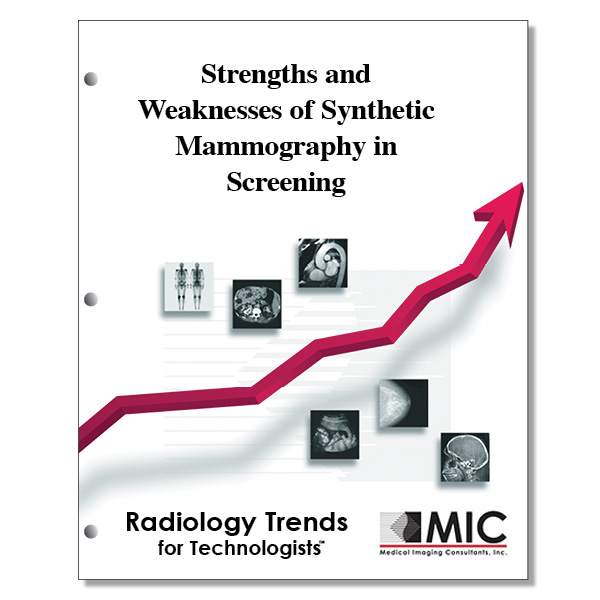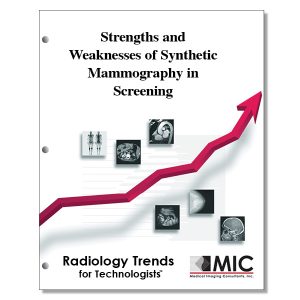

Strengths and Weaknesses of Synthetic Mammography in Screening
Synthetic mammography principles are reviewed and the role of synthetic mammography in screening is discussed.
Course ID: Q00572 Category: Radiology Trends for Technologists Modality: Mammography1.5 |
Satisfaction Guarantee |
$24.00
- Targeted CE
- Outline
- Objectives
This course has been approved for 1.50 Category A credits.
No discipline-specific Targeted CE credit is currently offered by this course.
Outline
- Introduction
- SM Acquisition
- Role of SM in Screening
- Reduced Radiation Dose
- Shorter Acquisition Time
- SM and Cancer Detection
- SM versus FFDM
- SM/DBT versus FFDM/DBT
- SM and Recall Rate
- Case Reviews of SMís Strengths, Weaknesses, and Artifacts
- SMís Strengths
- SMís Weaknesses
- SM Artifacts
- Subcutaneous Tissue Blurring
- Loss of Skin Resolution
- Decreased Axillary Contrast Resolution
- Pseudocalcifications
- Foreign-Body Artifacts
- Difficulty in Assessing for Motion Artifact
- SM Artifacts
- Other Considerations
- Future Directions
- Conclusion
Objectives
Upon completion of this course, students will:
- state the year when the FDA approved DBT
- list the limitations of FFDM/DBT, when compared to those of FFDM alone
- state the year SM was approved by the FDA to be used in combination with DBT data
- describe the SM process
- describe the purpose of manufacturer-specific algorithms
- state when the MQSA was enacted
- describe the federal radiation dose limits enforced by the MQSA
- contrast and compare multiple studies in regard to SM
- name the organizations that have campaigns focused on raising awareness of the need to lower radiation dose of medically necessary studies
- state the acquisition time ranges for DBT
- list the benefits of shorter acquisition times
- recall the prospective study that found SM had significantly better conspicuity than FFDM for calcifications and architectural distortions
- recall the study that did not have a true screening population
- list the strengths associated with SM
- list artifacts experienced by the authors’ early clinical implementation of SM
- describe the curvature of the compressed breast related to the compression plate to the Bucky grid
- describe burned-skin artifact
- describe the areas in the breast where decreased SM contrast resolution may occur
- describe aspects of breast composition that may cause structural noise in SM
- compare how foreign-bodies or metal artifacts appear on images from various modalities
- recall how metal artifacts appear on breast images
- list commercially available items that can help minimize artifacts associates with high-attenuation objects
- describe areas in the breast where special attention must be placed in order to detect motion
- recall the potential for SM to reduce radiation exposure
- list factors that SM can help make more conspicuous
